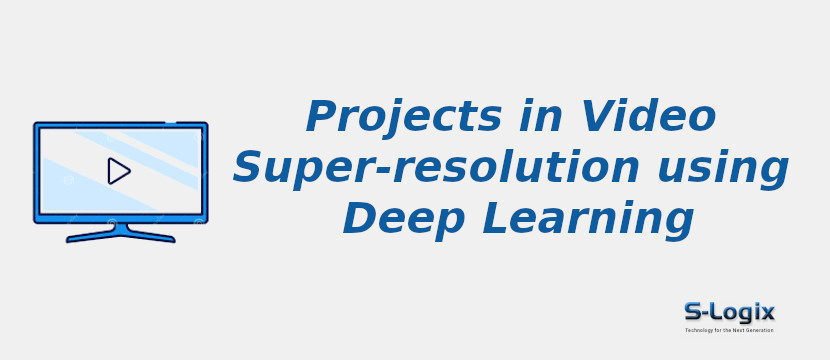Project Background:
Video super-resolution using deep learning revolves around addressing the challenge of enhancing the visual quality of low-resolution video content. In traditional video processing, factors such as compression, limited bandwidth, or low-quality recording equipment often result in videos with reduced resolution and degraded details. Video super-resolution aims to overcome these limitations by leveraging advanced deep learning techniques. This project involves the development of models based on convolutional neural networks (CNNs) or other deep neural architectures capable of learning complex mappings between low-resolution and high-resolution video frames. These models aim to capture intricate spatial and temporal dependencies in the data, allowing for the generation of sharper and more detailed video frames. This intersection of deep learning and video processing holds promise for improving the overall viewing experience across various domains, including entertainment, surveillance, and medical imaging.
Problem Statement
- The problem in video super-resolution involves addressing the inherent limitations of low-resolution video content.
-
Due to factors such as compression or suboptimal recording conditions, conventional video sources result in videos with diminished visual quality and details.
-
The project aims to overcome the limitation by developing robust models, capable of learning the complex relationships between low-resolution and high-resolution video frames.
-
It addresses spatial and temporal dependencies, ensuring that the generated high-resolution frames are sharper, temporally consistent, and visually realistic.
-
It also seeks to provide a scalable, adaptive, and data-driven approach to video super-resolution of low-resolution video content across diverse applications and industries.
Aim and Objectives
- Enhance the visual quality of low-resolution videos by applying deep learning techniques focusing on video super-resolution.
-
Create deep learning models based on CNNs to learn intricate mappings between low-resolution and high-resolution video frames.
-
Improve the spatial resolution and clarity of video frames, ensuring the generation of visually detailed and sharp images.
-
Address temporal dependencies in video sequences aiming for smooth transitions and coherent high-resolution video outputs over time.
-
Develop models that can generalize well across diverse video content and effectively handle various sources of degradation.
-
Explore the efficiency and real-time applicability of the super-resolution models to ensure practical usability in dynamic video streaming scenarios.
-
Establish and utilize appropriate performance metrics like PSNR or SSIM to quantitatively assess the quality of the super-resolved videos.
Contributions to Video Super-resolution using Deep Learning
1. The development of techniques specifically addresses the temporal consistency challenge in video super-resolution, ensuring smooth transitions and coherence between consecutive frames.
2.
Curating and sharing large-scale video datasets facilitates the training and evaluation of deep learning models for video super-resolution, enabling more robust and generalized solutions.
3.
Exploration of transfer learning methods allows pre-trained models on one type of video content to be adapted effectively to new and diverse video datasets, improving model generalization.
4.
Establishment and refinement of objective evaluation metrics such as PSNR, SSIM, or perceptual metrics, providing standardized ways to assess the quality and performance of super-resolution models.
5.
Adaptation and customization of video super-resolution techniques for specific domains, such as medical imaging or surveillance, showcasing the versatility and applicability of deep learning in diverse fields.
Deep Learning Algorithms for Video Super-resolution
- Convolutional Neural Networks (CNNs)
-
Generative Adversarial Networks (GANs)
-
Recurrent Neural Networks (RNNs)
-
Residual Networks (ResNets)
-
Enhanced Super-Resolution Convolutional Neural Networks (ESRCNN)
-
Super-Resolution Residual Network (SRResNet)
-
Deep Back-Projection Networks
-
Recursive Convolutional Networks
-
Multi-Frame Super-Resolution Networks
Datasets for Video Super-resolution
- Vimeo-90K
-
UCF101
-
DIV2K
-
REDs (REalistic and Dynamic Scenes)
-
CIFAR-10/100
-
Kinetics
-
YouTube-8M
-
SET5
-
SET14
-
4K Video Dataset
Performance Metrics
- Peak Signal-to-Noise Ratio (PSNR)
-
Structural Similarity Index (SSI or SSIM)
-
Mean Squared Error (MSE)
-
Root Mean Squared Error (RMSE)
-
Mean Absolute Error (MAE)
-
Visual Information Fidelity (VIF)
-
Frechet Inception Distance (FID)
-
Multi-Scale Structural Similarity Index (MS-SSIM)
Software Tools and Technologies
Operating System: Ubuntu 18.04 LTS 64bit / Windows 10
Development Tools: Anaconda3, Spyder 5.0, Jupyter Notebook
Language Version: Python 3.9
Python Libraries:
1. Python ML Libraries:
- Scikit-Learn
- Numpy
- Pandas
- Matplotlib
- Seaborn
- Docker
- MLflow
2. Deep Learning Frameworks:
- Keras
- TensorFlow
- PyTorch
